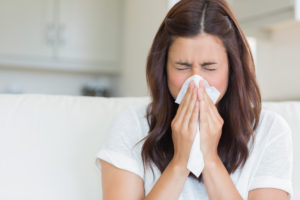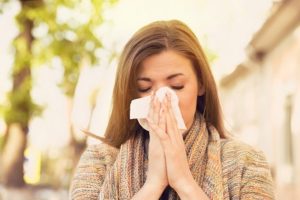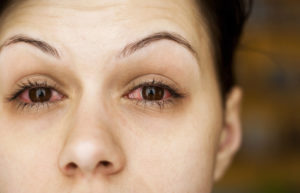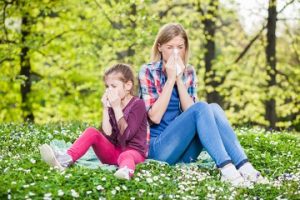Grass-Induced Allergic Reactions

As we enter the grass season in the Washington, DC, Northern Virginia, and Maryland metropolitan area, it is interesting to note that grasses can cause a multitude of symptoms. These symptoms may vary from mild to severe and are most notable from the months of May through July in the mid-Atlantic region. Grasses have been implicated in a variety of disorders ranging from allergic rhinitis (i.e., hay fever), allergic conjunctivitis, asthma, urticaria (i.e., hives), pruritus (i.e., generalized itching), angioedema (i.e., swelling episodes), and anaphylaxis.
The most common disorder caused by exposure to grasses is allergic rhinitis. Individuals with this condition experience symptoms which may include sneezing, runny nose, nasal congestion, post-nasal drip, itchy nose, itchy throat, sore throat, sinus congestion, sinus headaches, fatigue, and/or snoring.
Allergic conjunctivitis is manifested by itchy eyes, watery eyes, swollen eyes, and/or redness of the eyes. It is not unusual for individuals with allergic conjunctivitis to experience the feeling of their eyes sticking together from copious amounts of discharge from the eyes. Rarely, photophobia (i.e., sensitivity to light) may occur in severe cases.
Grasses may also exacerbate asthma symptoms in asthmatic patients. These patients may experience wheezing, shortness of breath, coughing, and/or chest tightness when exposed to grass pollen. Many of these individuals find it even more difficult to exercise outside when the grass pollen count it high. Such individuals should be encouraged to minimize their exposure to grass pollen as asthma may be life-threatening in severe cases.
Occasionally grass-allergic patients may develop itchy hives when exposed to high levels of grass pollen and/or when an individual’s skin comes in contact with grass. These highly grass-allergic patients should be advised to avoid contact with grass, as occasionally the hives can progress to more severe life-threatening symptoms. People who play sports on grassy areas are particularly at risk for this type of reaction.
Similar to patients that develop hives on contact with grasses is a condition where individuals develop generalized itching of their skin without the accompanying rash or hives. These patients should take the same precautions as the allergic individuals who develop hives from grass exposure.
Another related disorder that may occur upon exposure to grass is called angioedema. Individuals with this entity may develop swelling of different body parts that either come in direct contact with grasses or are exposed to grass pollen by indirect contact. Angioedema is a very serious sign, particularly since the swelling may occur internally, such as in the throat, which may obstruct an individual’s breathing. Patients with this disorder should be prescribed and taught how to use a self-injectable epinephrine device (e.g., EpiPen, Auvi-Q, Adrenaclick). If used, the patient is to go immediately to the closest emergency room.
On rare occasions a highly grass-sensitive individual may be exposed to an abundance of grass or grass pollen and develop anaphylaxis. Activities that cause grass stains on the skin (e.g., football, rugby) are more likely to cause anaphylaxis then other activities where hard direct physical contact with grass is not common (e.g., tennis, basketball). In any case, anaphylaxis is a medical emergency and anyone with anaphylaxis should be treated with epinephrine and be followed up immediately at the closest emergency room. It is imperative that these individuals carry a self-injectable epinephrine device (e.g., EpiPen, Auvi-Q, Adrenaclick).
As one can see from the examples above, grasses may cause many different symptoms among a variety of conditions. The symptoms may be mild, moderate, or severe. The board certified allergists at Black & Kletz Allergy have been treating individuals with grass allergies for over 50 years. If you suffer from any of the symptoms above in the Spring or Summer, please call our office for an allergy consultation in order for us to determine if you have grass or other allergies that may cause any of the symptoms above. We have 3 offices in the Washington, DC, Northern Virginia, and Maryland metropolitan area with office locations in Washington, DC, McLean, VA (Tysons Corner, VA), and Manassas, VA. We offer on-site parking at each location and the Washington, DC and McLean, VA offices are Metro accessible. There is a free shuttle that runs between the McLean, VA office and the Spring Hill metro station on the silver line. Black & Kletz Allergy specializes in treatment of both pediatric and adult patients. Alternatively, to schedule an appointment, you may click Request an Appointment and we will respond within 24 hours by the next business day. The allergists at Black & Kletz Allergy pride themselves in providing superior allergy and asthma care in a professional and compassionate environment.




 Now that it is officially Spring, many people will begin to feel the unwanted allergic symptoms of
Now that it is officially Spring, many people will begin to feel the unwanted allergic symptoms of  Now that it is March and the Spring has begun, many individuals will experience irritated eyes. The typical eye symptoms that allergic individuals may notice include itchy eyes, watery eyes, puffy or swollen eyelids, thick sticky discharge, eyelids sticking together especially in the mornings when awakening. In most cases, tree and/or grass pollen allergy is the cause, however allergies to other allergens such as molds, pets, dust mites, and/or cockroaches may be the allergic cause.
Now that it is March and the Spring has begun, many individuals will experience irritated eyes. The typical eye symptoms that allergic individuals may notice include itchy eyes, watery eyes, puffy or swollen eyelids, thick sticky discharge, eyelids sticking together especially in the mornings when awakening. In most cases, tree and/or grass pollen allergy is the cause, however allergies to other allergens such as molds, pets, dust mites, and/or cockroaches may be the allergic cause. March is the month that many trees begin pollinating in the Washington, DC metropolitan area. As temperatures begin to climb, we will start seeing a light yellowish coating on our automobiles. For many allergy sufferers, this represents the onset of misery for many individuals who are sensitized to tree pollen.
March is the month that many trees begin pollinating in the Washington, DC metropolitan area. As temperatures begin to climb, we will start seeing a light yellowish coating on our automobiles. For many allergy sufferers, this represents the onset of misery for many individuals who are sensitized to tree pollen.